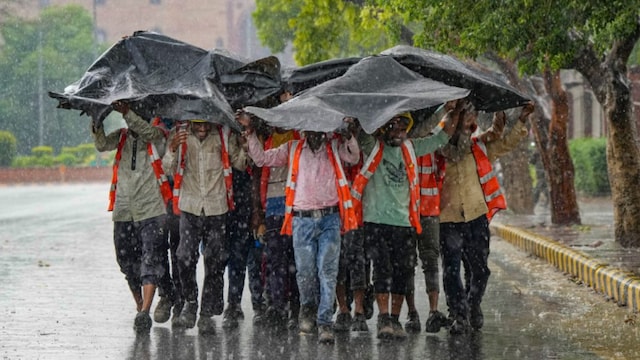Source :NEWS18 NEWS
Last Updated:May 23, 2025, 18:03 IST
The deadly sandstorm and rainfall across Delhi-NCR on Wednesday serves as a stark reminder of the importance of preparedness when extreme weather strikes
During a storm, avoid standing under trees, near electric poles, or close to tall structures that can collapse. (PTI Photo)
A ferocious sandstorm that swept across Delhi-NCR on Wednesday evening, leaving at least six dead, has reignited concerns about how to stay safe during calamities. Two fatalities were reported from Delhi, while Ghaziabad reported at least two (possibly three) deaths after high-speed winds and heavy rainfall brought the NCR to a standstill on May 21.
What You Must Do When Weather Turns Violent
Recommended Stories
Wednesday’s storm serves as a stark reminder of the importance of preparedness when extreme weather strikes. Authorities and experts urge residents to follow these safety tips:
If You’re Indoors:
- Secure all windows and doors. In homes with weak roofs, move to sturdier inner rooms like bathrooms.
- Turn off the main power supply to prevent electrical accidents.
- Check for gas leaks and shut off cylinders if needed.
- Keep emergency essentials – water, flashlight, basic medicines, documents – readily accessible.
If You’re Outside:
- Take shelter immediately in a sturdy building or vehicle.
- Avoid standing under trees, near electric poles, or close to tall structures that can collapse.
- In the open with no shelter? Lie flat on the ground and cover your head with your arms.
Driving During A Storm:
- Reduce speed and pull over safely, ideally in an emergency bay.
- Avoid parking under trees, poles, or billboards.
- Stay inside the vehicle with seatbelts fastened. Keep hazard lights on, engine off, and windows shut.
- If the wind threatens to flip the car, exit and lie flat on the ground covering your head.
- After the storm, check your route for debris or downed power lines before moving on.
Dust Storm And Heavy Rain In Delhi-NCR
The Wednesday storm didn’t just end in tragedy; it left countless injured and caused widespread structural damage. In a particularly heart-wrenching incident in Greater Noida, a woman and her two-year-old grandson died when a tin shed, dislodged by the gale-force winds from the 21st floor of a high-rise, came crashing down upon them.
In several places across the NCR, trees were left uprooted across residential and commercial areas, electric poles crumbled, and massive billboards were torn apart, causing panic and gridlock on already congested roads.
IndiGo Flight Hit By Hailstorm
As chaos unfolded on the ground, the skies were no safer. An IndiGo flight en route to Srinagar from Delhi with over 200 passengers was caught in the heart of the storm. A chilling video now circulating widely on social media shows terrified passengers crying and praying as the aircraft battled intense turbulence and hail.
The airline confirmed that flight 6E 2142 encountered a sudden hailstorm mid-air, but reassured that all protocols were followed and the aircraft landed safely in Srinagar. However, photos suggest the front fuselage of the aircraft was visibly damaged, though no official statement on the extent of the damage has been released yet.
A Look At The Deadliest Storms
Wednesday’s mayhem joins a long list of devastating weather events that have scarred the nation:
- Odisha Super Cyclone, 1999: Winds at 260 km/h claimed over 10,000 lives and destroyed near about 20 lakh homes.
- Cyclone Amphan, 2020: Ravaged West Bengal and Odisha with 240 km/h gusts, leaving 128 dead and over Rs 13,000 crore in damages.
- Andhra Pradesh Cyclone, 1977: One of the deadliest, with estimates of 10,000–50,000 deaths. Spurred India’s first modern cyclone warning systems.
- Kerala Floods, 2018: Torrential monsoons and storm winds led to over 400 deaths and displaced over 10 lakh people.
- Cyclone Tauktae, 2021: Pounded Gujarat and Maharashtra with 185 km/h winds, killing at least 100 and submerging Mumbai and Surat.
As weather patterns grow increasingly erratic, experts warn that the frequency and intensity of such storms may rise. Residents are urged to stay tuned to weather advisories, follow emergency protocols, and prioritise safety over routine.
- First Published:
May 23, 2025, 18:01 IST
SOURCE : NEWS 18







